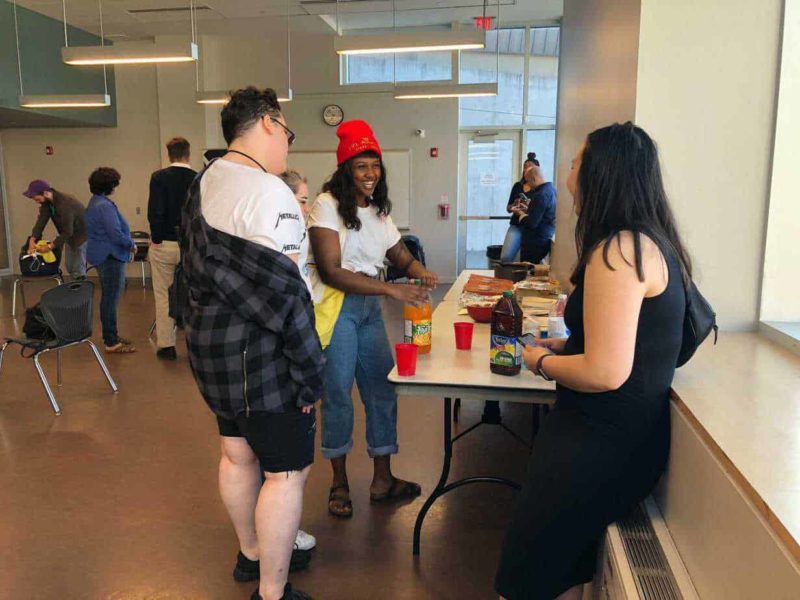
Somehow it’s not surprising that a conversation about Scarborough’s arts scene with four emerging local writers starts with a hunt for a space to sit down and talk in downtown Toronto.
After all, artists such as Natasha Ramoutar, Adrian De Leon, Leanne Simpson and Chelsea La Vecchia — all University of Toronto Scarborough graduates, and now part of an informal writers’ collective — are trying to claim their own space within and outside of the Toronto arts landscape. While these artists are proud of their ties to Scarborough, the place that claims their roots is not immediately associated with artistic excellence by most outsiders.
The cold weather forces the friends underground, into the system of pedestrian walkways that connects much of Toronto’s financial district office towers. In the end, they settle for some space in one of the fluorescent-lit hallways, pulling together two benches, and dumping an assortment of bags, coats and scarves into a pile before they start swapping notes.
Inevitably, the conversation turns to Nuit Blanche, Toronto’s all-night art party, which made its first foray into Scarborough this fall. After exulting about the amazing evening of performances and visual arts displays, the foursome parse the particulars of the event — especially the difference in the way Scarborough natives experienced it versus those who commuted in.
In a way, Nuit Blanche Scarborough is the perfect example of the dichotomy around the region’s cultural currency. Outsiders usually think of Scarborough as a cultural wasteland, barring flashes in the pan such as painter Doris McCarthy, rapper Maestro Fresh Wes or actor Mike Myers. To non-residents, Scarborough evokes images of decrepit high-rises and ugly strip malls, with vast stretches of concrete in between. Meanwhile, those who make Scarborough their home have always spoken fondly of a community rich in the arts and humanity, hiding in plain sight.
A shared sense of Scarborough
When she first started studying English literature and creative writing at the University of Toronto Scarborough, La Vecchia says her friends made fun of her; they dismissed the area as a working-class part of town. In fact, until she started commuting to class from her home in adjacent East York, she too thought of Scarborough as that part of the city that voted in Toronto’s infamous former mayor, the late Rob Ford.
De Leon’s wary of the new-found attention Nuit Blanche generated. Something about that night felt “a little strange,” Ramoutar agrees. “I think it almost felt [as if] the people coming from downtown were coming to look at it as if it were a spectacle.”

De Leon is uncomfortable with the way Scarborough is now being portrayed as a cultural destination, its social capital pre-curated by Google map searches and hipster Yelp reviews. Visitors might take pride in their cosmopolitan ventures to seemingly uncharted areas, marvelling at their travel to Toronto’s east end and the three buses it took to get there. But De Leon was a regular on that route for years, navigating the neighbourhood’s significant transit challenges everyday just to get to class. It’s the subject of much of his new book of poetry.
For these four writers who came of age in Scarborough, engaging with its spaces and stories is a part of their daily practice. Their writing draws from longer traditions of storytelling located in the neighbourhoods they grew up in, and the intimate knowledge of some of its lesser-known spaces.
De Leon, for instance, points to the Indigenous histories of Tabor Hill, one of Ontario’s oldest ossuaries (located at Lawrence Avenue and Bellamy Road) or the Seneca village at the mouth of the Rouge River as possible sources for stories, while Simpson writes from her own experience of staying at several mental health facilities across Scarborough after she was diagnosed with bipolar disorder at the end of high school.
“This is the place where we all came to begin our stories,” says Simpson, adding that even though she’s now pursuing an MFA from the University of Guelph, she still seeks out her University of Toronto Scarborough peers because they understand her context. “I don’t have to explain myself or justify my stories. We grew together as writers.”
“Last year I was in Hawaii, and a bunch of different places, on a Fulbright scholarship,” De Leon notes. “But I still end up writing stories about Scarborough.”
For Ramoutar, it’s about capturing a moment. “Those personal and intimate experiences — of going to class at UTSC or having a bonfire at the Bluffs — what actually happened here with your family and your friends.”

All four emerging writers draw inspiration from the fact that they can recognize themselves in the literature and other artistic expressions now coming out of Scarborough. They are excited by the growing community of artists from other disciplines such as film, visual arts and theatre who are exploring similar themes, and whose works inform their own writing.
“The celebration [of Scarborough], that’s what it is. That we can geek out poetically when talking about intersection and landmarks,” De Leon says. “That we also know the same mythology about a bridge, or went on the same hike, the same strip mall.”
Scarborough’s artistic revolutionaries
Even before they met in university, De Leon, Ramoutar and Simpson were finding inspiration in a local youth-led movement launched by a self-described community of “artists, activists, free-thinkers and revolutionaries.”
As high school students, they marvelled at the other young people expressing themselves and their life experiences through spoken word, poetry and song, among other art forms, at events hosted by Reaching Intelligent Souls Everywhere (R.I.S.E).
The movement’s charismatic founder, Randell Adjei, 27, calls it healing through the arts. When he sees young people struggling today — especially those that come from racialized and/or underprivileged backgrounds — he urges them to use their voices to advocate for themselves.
“I truly believe that words can create change,” he told the audience gathered on Nov. 5, 2018, for R.I.S.E’s weekly open-mic at Burrows Hall in Malvern, an east-Scarborough neighbourhood. “The power of our words can transcend hatred. So, turn to the person beside you, and tell them, ‘You are excellent.’”
R.I.S.E was born partially out of Adjei’s own frustrations as a young Black man growing up in Scarborough. A bright but bored kid at school, he had a troubled youth. His interest in wordplay and a timely literary intervention by a high school teacher gave him a voice to share his story. He started R.I.S.E in 2012 to give a platform to other young people like himself. The initial gatherings drew 23 youth to a resource centre inside Scarborough Town Centre mall.

“It was magical,” Adjei says. He was 19 at the time, and had put in whatever little money he’d saved up to start the weekly open mic series. “There was a mirror on one side, like a whole wall. And it created this really intimate space.”
Through word of mouth, those 23 people grew into hundreds of young aspiring artists, and the weekly events moved first to the Tropicana resource centre and then to Burrows Hall in April 2013. On some nights, close to 100 people would show up.
In the beginning, he had no specific vision for the group. He simply wanted to give space to young and talented people whose talent was consistently overlooked, and who were spoken to only when something bad happened in the community.
“A friend once asked me, ‘What happens if you plant an acorn seed?’ I said, ‘It grows a tree.’ He said, ‘No, it can grow a forest.’”
“I never thought this event could create opportunities for young people to get paid to do the arts, to collaborate with other organizations,” Adjei says. “Now I am starting to see the forest branch out.”
Like De Leon, Adjei points to his forebears. He credits watching rappers such as Maestro Fresh Wes and Saukrates with sparking his own artistic interests.
“I think Scarborough has been having its renaissance for a long time, and I think the city is just finally coming to see it,” he says.
Then Nuit Blanche came to town
To finally see Scarborough host Nuit Blanche on Sept. 29, 2018, was a long time coming for Adjei.
He says he’s heard resistance from organizers over the years who worried it might be “too dangerous” to hold the festival here.
Nuit Blanche Scarborough curator Alyssa Fearon says she’s heard that sentiment too, but from trolls outside the community. “But I just ignored that and concentrated on the artists instead.”

Fearon, herself from Scarborough, says the art party not only put her hometown on Toronto’s cultural map — countering what she calls the “dominant perception” that there’s nothing artistic happening in Scarborough — but opened some long-time residents’ eyes to the scene bubbling under their feet.
“Even some people from Scarborough came up to me and told me they never thought about there being a culture scene in their community,” she says.
“For me, it’s something I had always seen and recognized in Scarborough,” she continues. “Part of making that exhibition happen… was for people to see this area through my eyes.”
Since the success of Nuit Blanche Scarborough, Fearon has joined the Art Gallery of Southwestern Manitoba as curator. But she plans to keep an eye on the arts scene in her hometown and hopes the legacy of the collaborations forged for this year’s Nuit Blanche will continue.
There’s definitely a collective consciousness shared by Scarborough’s emerging artists and writers, say De Leon, Ramoutar, La Vecchia and Simpson.
“A lot of that is seeing these names pop up at literary festivals or in different reports, and you think — ‘Oh cool! They’re from Scarborough,’” says De Leon.
“My favourite is when you meet another artist from Scarborough, you can pin it right down to an intersection. Where are you from? I am from Meadowvale and Sheppard. Where you are from? I am from Kennedy and Eglinton,” says Ramoutar.
As for Adjei, he’s preparing to represent himself — and Scarborough — on a national and international level as a newly published author. His book of poems, I Am Not My Struggle released on Nov. 3, 2018.
“There’s roses that grow under the concrete here in Scarborough,” he says. “I want to be recognized as one of them; and inspire the next rose to rise, to grow, to blossom and bloom.”[end]
This piece was edited by Robin Perelle. Sign up here for our Scarborough newsletter.



